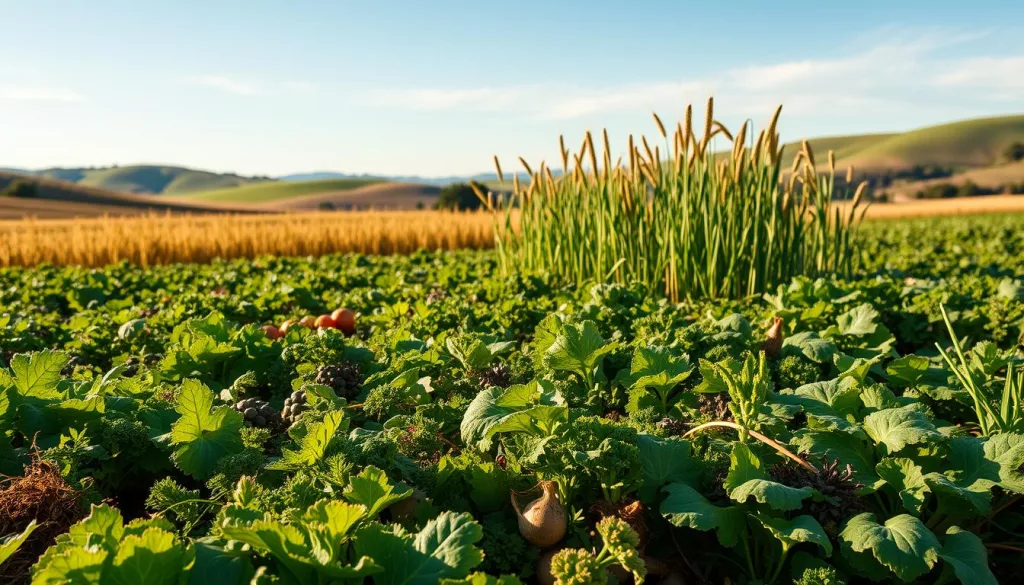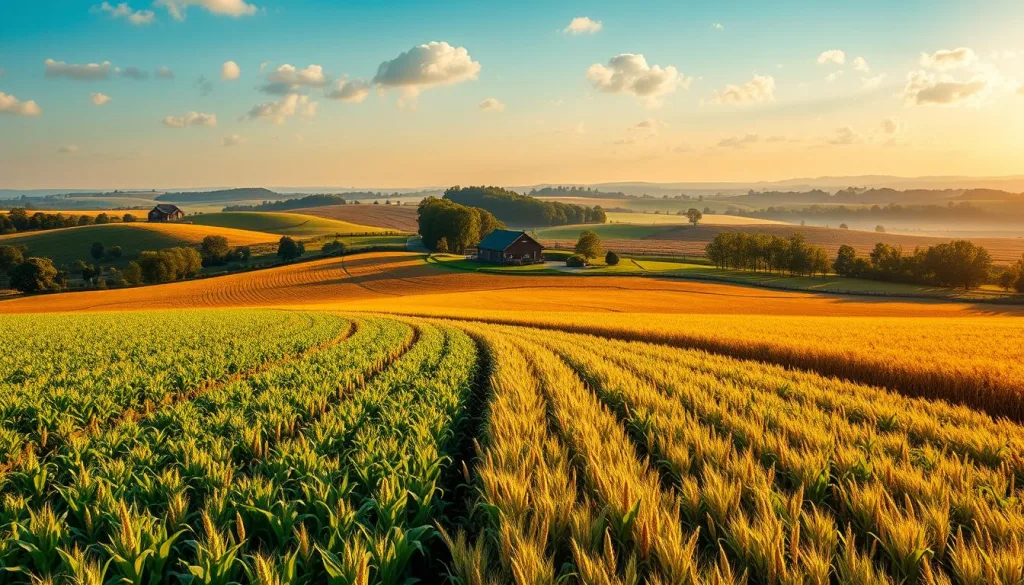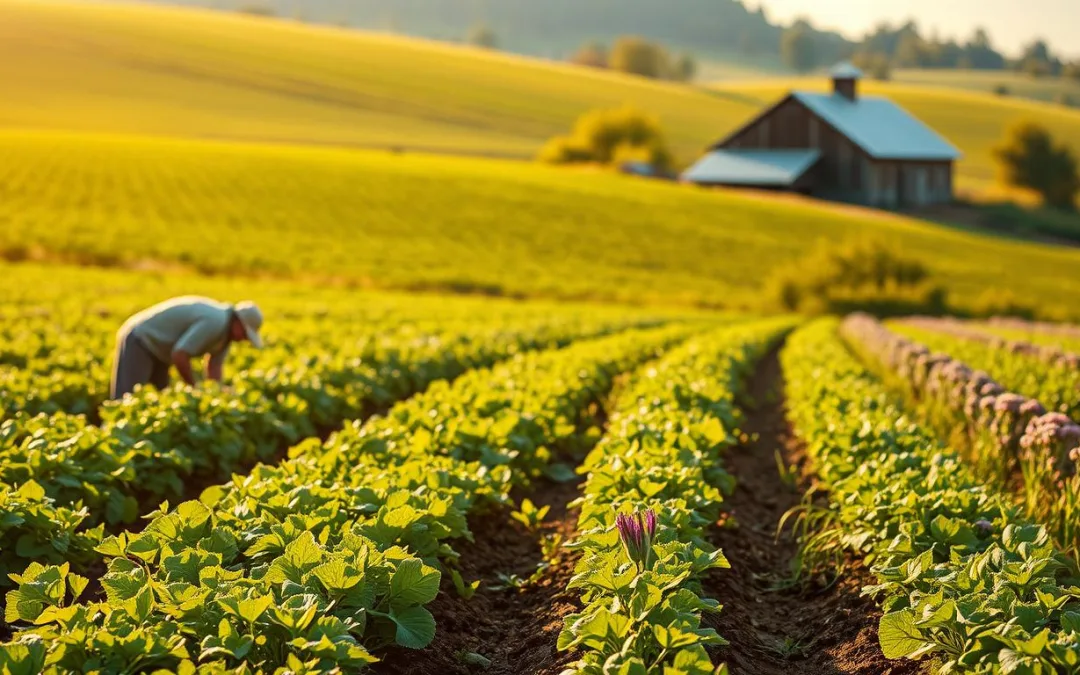Crop rotation is key to sustainable agriculture practices. It means changing crop types in a cycle. This makes farming more dynamic and resilient.
The role of crop rotation in farming is huge. It helps by mixing different plants, improving soil, and fighting pests. Studies show that using different crops can boost yields by up to 38% over single-crop farming.
By using crop rotation, farmers tackle many environmental issues. They can cut down greenhouse gas emissions by up to 88%. They also boost soil’s organic carbon by 8%, making farming greener.
Key Takeaways
- Crop rotation naturally enhances soil health and pest control
- Diversified rotations can increase crop yields by 38%
- Reduces greenhouse gas emissions significantly
- Improves soil organic carbon stocks
- Decreases reliance on synthetic agricultural inputs
Understanding the Fundamentals of Crop Rotation
Crop rotation is key to sustainable farming. It helps improve soil health and boosts crop yields. Farmers change the crops grown in a field over time.
- Improves soil nutrient balance
- Reduces pest and disease pressures
- Boosts ecosystem resilience
Definition and Basic Principles
Crop rotation is about the order of planting. Different plants interact uniquely with soil ecosystems. Legumes fix nitrogen, and root crops break up soil.
“Crop rotation is nature’s way of maintaining agricultural balance and sustainability.” – Regenerative Agriculture Expert
Historical Development of Rotation Methods
Early farmers knew the value of crop rotation. The three-field system in medieval Europe was a smart way to manage land.
Core Components of Rotation Systems
Good crop rotation needs a few things:
- Diverse crop selection
- Strategic planting sequences
- Understanding plant family interactions
- Soil health monitoring
Studies show crop rotation can up yields by 10-25% and cut pests by 50%. It’s a vital part of sustainable farming.
The Importance of Crop Rotation in Sustainable Farming
Crop rotation is key to sustainable farming. It keeps soil healthy and boosts farm productivity. It’s vital for organic farming methods.
The USDA Organic Regulations say crop rotation is essential. This smart move tackles many big challenges:
- Preventing soil-borne diseases
- Managing insect pest populations
- Controlling weed growth
- Improving soil organic matter content
- Enhancing nutrient management
Nitrogen-fixing legumes are important in crop rotation. They help by adding nutrients to the soil after being followed by crops that need a lot of nitrogen.
The ancient “food, feed, fallow” system used by Romans showed they knew about crop rotation’s benefits in keeping soil fertile.
Organic farming uses crop rotation to cut down on chemical use. Rotating crops yearly stops pests and diseases and boosts biodiversity. Cover crops also help by keeping soil in place and adding to the ecosystem’s health.
With smart crop rotation, farmers can build strong, sustainable farms. These farms have better yields and are better for the environment.
Maximizing Soil Health Through Strategic Rotation
Sustainable farming needs smart soil management. Crop rotation is a key strategy for better soil health and keeping soil fertile over time.
Strategic crop rotation is a whole approach to better soil. By picking and arranging crops wisely, farmers can greatly improve soil quality and farm output.
Nutrient Cycling and Management
Good nutrient cycling is key for green farming. Different crops use soil nutrients in their own ways. This creates a cycle that helps soil health.
- Legumes fix atmospheric nitrogen, cutting down on fertilizer needs
- Deep-rooted crops loosen tight soil layers
- Diverse roots add different organic matter
Organic Matter Enhancement
Crop rotation really boosts organic matter. Studies show a 52% increase in soil organic matter with a smart three-year rotation plan.
“Healthy soil is the foundation of sustainable agriculture” – Regenerative Farming Experts
Soil Structure Improvement
Rotating crops changes soil structure for the better. It improves water retention and cuts down on erosion. Key benefits include:
- Water holding capacity goes up by 20%
- Soil erosion drops by 70%
- Pest problems fall by 60%
By following these soil health tips, farmers can build strong, productive farms. These farms are good for the environment and the economy.
Essential Crop Families for Rotation Planning

Sustainable food production needs smart crop diversification. It’s important to know each crop family’s unique traits. This knowledge helps create effective rotation plans that keep soil healthy and boost farm productivity.
The main crop families for planning include:
- Grasses (Poaceae): Wheat, corn, oats
- Legumes (Fabaceae): Beans, peas, clover
- Brassicas (Mustard family): Cabbage, broccoli, kale
- Alliums: Onions, garlic, leeks
- Solanaceae: Tomatoes, potatoes, peppers
Each family offers special benefits. Legumes, for example, help fix nitrogen in the air, cutting down on synthetic fertilizers. Grasses add organic matter with their deep roots, improving soil and nutrient flow.
Using crop diversification needs careful planning. Farmers should not plant the same family back-to-back to avoid nutrient loss and pest issues. Rotating crops helps keep soil fertile, cuts down on chemicals, and supports sustainable farming for the long haul.
Natural Pest and Disease Management Benefits
Crop rotation is a key strategy in protecting the environment. It helps farmers manage pests and diseases naturally. By changing crop sequences, farmers can stop harmful cycles that harm plants.
Learning about pest management through organic farming methods shows many benefits:
Breaking Pest Life Cycles
By rotating crops, farmers can stop pests from reproducing. This is because they remove the pests’ favorite plants. Studies show that:
- Changing crops every two years can lower certain disease levels
- At least two-year breaks can stop bacterial spot infections
- Rotation fights widespread root diseases like take-all root rot
Disease Prevention Strategies
Targeted rotation approaches can greatly lower disease risks. For example, managing clubroot in Brassica crops needs careful planning to stop infections.
Beneficial Insect Attraction
Diverse crop rotations attract good insects, creating natural pest control. These interactions help keep the farm ecosystem balanced. This reduces the need for chemicals.
Thoughtful rotation strategies improve soil health and biodiversity. They help create strong, natural agricultural systems.
Economic Advantages of Rotation Systems

Sustainable farming is more than good for the planet. It also boosts a farmer’s bottom line. Research shows that smart crop rotation can make farms more profitable.
Crop rotation brings many economic benefits. Farmers using sustainable methods can see their finances grow in several ways:
- Reduced input costs by 15-20%
- Enhanced crop yield
- Improved climate resilience
- Lower risk of crop failure
Corn and soybean farmers in the U.S. can gain a lot from rotation. Studies indicate that three- and four-year rotations can up corn yields by 2-4% and soybean yields by 10-17%. This means more money for farmers.
Smart farmers see crop rotation as a key economic strategy. By growing different crops, using fewer chemicals, and cutting down on synthetic fertilizers, they save money. They stay competitive while keeping productivity high.
Strategic crop rotation can be the difference between marginal profits and agricultural sustainability.
The long-term benefits are clear. Rotational systems lower costs for nitrogen pollution and environmental damage. They also help farms have more stable income, thanks to sustainable practices.
Implementing Effective Rotation Schedules
Sustainable farming depends on smart crop rotation planning. Farmers can change their farming by making detailed rotation plans. These plans help improve soil health and boost crop yields.
Good crop rotation needs careful thought. It aims to make soil better, control pests, and increase yields.
Season-by-Season Planning
Rotation plans usually last three to ten years. They help farmers use the best strategies. Important things to think about include:
- Local climate conditions
- Soil nutrient needs
- What crops are in demand
- How to manage pests
Crop Sequencing Guidelines
Improving soil health means choosing crops wisely. Here are key tips:
- Put legumes before crops that need a lot of nitrogen
- Switch between crops with deep and shallow roots
- Use cover crops to improve soil
| Crop Rotation Strategy | Yield Improvement | Soil Health Impact |
|---|---|---|
| Two-Year Rotation | 29% Increase | Moderate Improvement |
| Four-Year Rotation | 48% Increase | Significant Enhancement |
Record Keeping Methods
Keeping accurate records is key for crop rotation success. Farmers should track:
- When they plant
- The type of crop
- Soil nutrient levels
- Pest management efforts
“Precision in planning creates resilience in agriculture” – Modern Farming Insight
By using these strategies, farmers can make farming more sustainable. This leads to healthier soil and better crops over time.
Cover Crops and Their Role in Rotation
Cover crops are key in keeping the soil healthy. They change how we farm, making it better for the environment. These plants help keep the soil fertile, which is good for farming in the long run.
Farmers use cover crops to solve big problems:
- Prevent soil erosion
- Enhance nutrient cycling
- Improve soil structure
- Reduce synthetic fertilizer dependency
Legumes like clover and vetch are special because they fix nitrogen from the air. This means they add nutrients to the soil without needing chemical fertilizers. Studies show that these cover crops can really boost soil nitrogen, helping it stay healthy.
| Cover Crop Type | Primary Benefits | Nitrogen Fixation Capability |
|---|---|---|
| Clover | Soil protection, nitrogen fixation | High |
| Vetch | Erosion control, nutrient enhancement | Moderate to High |
| Rye | Weed suppression, soil structure | Low |
Choosing the right cover crops can cut down water runoff by 27% and reduce soil erosion. Plants like radishes help break up hard soil, making it easier for roots to get nutrients. This also helps good bugs and microorganisms in the soil.
By picking different cover crops, farmers can create strong, green farms. These farms keep the soil fertile, cut down on harm to the environment, and help farming stay sustainable.
Conclusion: Embracing Crop Rotation for Sustainable Agriculture
Crop rotation is key in sustainable farming. It changes how farmers grow crops from just one type to a mix. Sustainable food production needs new ways to keep soil healthy and crops growing well.
Studies show big benefits from crop rotation. Farmers see up to a 20% boost in crop yields and a 15% drop in pests. It’s not just about changing crops. It’s a way to make soil better, use less chemicals, and keep nature in balance. Legumes help by adding nutrients to the soil, making farming self-sustaining.
Crop rotation is more than a farming trick. It’s about taking care of the environment. By growing different crops, farmers stop soil erosion, help animals, and support good bugs. This helps not just the farm but the world, ensuring food for future generations.
Looking ahead, crop rotation is a big answer to environmental problems. Farmers who use it are not just growing food. They are building strong, healthy ecosystems that can face climate changes and keep food production going for years.
FAQ
What exactly is crop rotation?
Why is crop rotation important for soil health?
How does crop rotation help manage pests and diseases?
What are the economic benefits of implementing crop rotation?
How often should crops be rotated?
What are cover crops, and how do they support crop rotation?
Can crop rotation be used in organic farming?
What challenges might farmers face when implementing crop rotation?
Source Links
- What Is Sustainable Agriculture? – https://www.ucsusa.org/resources/what-sustainable-agriculture
- Diversifying crop rotation increases food production, reduces net greenhouse gas emissions and improves soil health – Nature Communications – https://www.nature.com/articles/s41467-023-44464-9
- Regenerative Agriculture 101 – Everything you need to know – 2023 – Common Ground Film – https://commongroundfilm.org/regenerative-agriculture-101-everything-you-need-to-know-2023/
- Importance and Future of Sustainable Agriculture – https://online.maryville.edu/blog/importance-and-future-of-sustainable-agriculture/
- 🎒 Online Agriculture Undergraduate Tutors Spires™ | Agriculture Fundamentals: Essential Concepts And Approaches – https://spires.co/online-agriculture-tutors/undergraduate/agriculture-fundamentals-essential-concepts-and-approaches
- PDF – https://www.ams.usda.gov/sites/default/files/media/Crop Rotation in Organic Farming Systems_FINAL.pdf
- Exploring the Role of Crop Rotation in Sustainable Agriculture – https://www.adama.com/south-africa/en/learning/sustainability/crop-rotation-sustainable-agriculture
- Maximizing Soil Health and Crop Yields: The Power of Rotation, Cover Crops, and Integrated Pest Management – – https://farmonaut.com/precision-farming/maximizing-soil-health-and-crop-yields-the-power-of-rotation-cover-crops-and-integrated-pest-management/
- What is Crop Rotation and Why Do We Need It? – https://www.logineko.com/knowledge/what-is-crop-rotation-and-why-do-we-need-it/
- Crop Rotation in the Garden – Maine Organic Farmers and Gardeners – https://www.mofga.org/resources/gardening/crop-rotation-in-the-garden/
- NRCS-CoverCrop_OREGON-2014_PROOF_V2 – https://tilth.org/app/uploads/2023/01/Crop-Rotation-in-Organic-Systems-Oregon-Implementation-Guide55.pdf
- Crop rotation: Enhancing Organic Growth with Crop Rotation Techniques – FasterCapital – https://fastercapital.com/content/Crop-rotation–Enhancing-Organic-Growth-with-Crop-Rotation-Techniques.html
- Management of Diseases with Crop Rotation – https://www.organic-crop-production.com/organic_crop_production/crop_rotation_organic_farms/management_diseases_crop_rotation.htm
- Crop Rotation: Definition & Benefits – https://www.vaia.com/en-us/explanations/nutrition-and-food-science/food-sustainability-agriculture/crop-rotation/
- PDF – https://www.ucsusa.org/sites/default/files/attach/2017/05/rotating-crops-report-ucs-2017.pdf
- Benefits of Crop Rotation on Climate Resilience and Its Prospects in China – https://www.mdpi.com/2073-4395/12/2/436
- Mastering Crop Rotation: Boost Soil Health and Yields with Sustainable Agriculture Practices – – https://farmonaut.com/precision-farming/mastering-crop-rotation-boost-soil-health-and-yields-with-sustainable-agriculture-practices/
- 8 Benefits of Crop Rotation for Soil Health | Verdesian – https://vlsci.com/blog/crop-rotation-benefits/
- Crop Rotation: Benefits Of Using And Application Strategies – https://eos.com/blog/crop-rotation/
- Sustainable Crop Rotation Strategies for Long-Term Farming Success – https://thefarminginsider.com/sustainable-crop-rotation-strategies/
- Importance of Cover Crops to Farming Operations – https://www.keystonebioag.com/article/importance-of-cover-crops-to-farming-operations/
- Cover Crops for Sustainable Cropping Systems: A Review – https://www.mdpi.com/2077-0472/12/12/2076
- The Benefits of Crop Rotation and Diversity – U.S. Farmers & Ranchers in Action – https://usfarmersandranchers.org/stories/sustainable-food-production/the-benefits-of-crop-rotation-and-diversity/
- Crop Rotation: The Secret to Farming Success (Learn Why It’s Key for Sustainability) – CSA Farm Directory – https://csafarms.ca/crop-rotation-the-secret-to-farming-success-learn-why-its-key-for-sustainability/
- 5 Benefits of Crop Rotation for Sustainable Agriculture | Crop Management – https://tracextech.com/5-benefits-of-crop-rotation-for-sustainable-agriculture/


